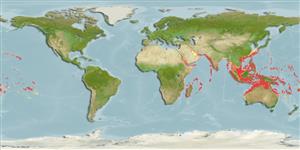Common names from other countries
>
Scombriformes (Mackerels) >
Scombridae (Mackerels, tunas, bonitos) > Scombrinae
Etymology: Gymnosarda: Greek, gymnos = naked + Greek, sarde = sardine; 1598 (Ref. 45335).
More on author: Rüppell.
Environment: milieu / climate zone / depth range / distribution range
Ecologia
marinhas associadas(os) a recifes; oceanódromo (Ref. 51243); intervalo de profundidade 0 - 250 m (Ref. 86942). Tropical; 20°C - 28°C (Ref. 5313); 31°N - 30°S, 32°E - 130°W (Ref. 168)
Indo-Pacific: Red Sea and East Africa to French Polynesia, north to Japan, south to Australia.
Tamanho / Peso / Idade
Maturity: Lm ? range ? - ? cm
Max length : 248 cm FL macho/indeterminado; (Ref. 40637); common length : 190 cm NG macho/indeterminado; (Ref. 9710); peso máx. publicado: 131.0 kg (Ref. 168)
Espinhos dorsais (total) : 13 - 15; Raios dorsais (total) : 12 - 14; Espinhos anais: 0; Raios anais : 12 - 13; Vértebras: 38. This species is distinguished by the following characters: body elongate and moderately compressed; mouth fairly large, upper jaw reaching to middle of eye; 14 to 31 large, conical teeth on upper jaw, 10 to 24 on lower jaw; 2 patches of villiform teeth on upper surface of tongue; total gill rakers on first gill arch 11-14; D1 XIII-XV, its border almost straight, the second followed by 6-7 finlets, dorsal fins close together; anal fin followed by 6 finlets; pectoral fins with 25-28 rays; interpelvic process large and single; lateral line strongly undulating; body naked posterior to corselet except for lateral line, dorsal-fin base, and caudal keel; caudal peduncle slender, with a well-developed lateral keel between 2 smaller keels on each side. Colour of back and upper sides brilliant blue-black, lower sides and belly silvery; no lines, spots or other markings on body; anterior tip of first dorsal fin dark; other fins greyish (Ref. 9684).
An offshore species found mainly around coral reefs. Generally solitary or occur in small schools of six or less. Preys on small schooling fishes such as Decapterus, Caesio, Nasio, Cirrhilabrus, Pterocaesio and squids. Caught mainly by pole-and-line. Marketed canned and frozen (Ref. 9684, 48637). Adults may be ciguatoxic (Ref. 37816). Minimum depth reported taken from Ref. 128797.
Ciclo de vida ou comportamento de acasalamento
Maturities | Reprodução | Spawnings | Egg(s) | Fecundities | Larvas
Collette, B.B. and C.E. Nauen, 1983. FAO Species Catalogue. Vol. 2. Scombrids of the world. An annotated and illustrated catalogue of tunas, mackerels, bonitos and related species known to date. Rome: FAO. FAO Fish. Synop. 125(2):137 p. (Ref. 168)
Status na Lista Vermelha da UICN (Ref. 130435)
CITES (Ref. 128078)
Not Evaluated
Ameaça para os humanos
Reports of ciguatera poisoning (Ref. 168)
Uso pelos humanos
Pescarias: pouco comercial; peixe esportivo: sim
Ferramentas
Relatórios especiais
Baixar XML
Fontes da internet
Estimates based on models
Preferred temperature (Ref.
115969): 20.9 - 28.2, mean 26.5 (based on 938 cells).
Índice de diversidade filogenética (Ref.
82804): PD
50 = 1.0000 [Uniqueness, from 0.5 = low to 2.0 = high].
Bayesian length-weight: a=0.01072 (0.00643 - 0.01784), b=3.06 (2.92 - 3.20), in cm Total Length, based on LWR estimates for this species & (Sub)family-body (Ref.
93245).
Nível Trófico (Ref.
69278): 4.5 ±0.75 se; based on food items.
Resiliência (Ref.
120179): Baixo, tempo mínimo de duplicação da população 4,5 - 14 anos (Assuming tmax>10).
Fishing Vulnerability (Ref.
59153): Very high vulnerability (90 of 100).
Climate Vulnerability (Ref.
125649): Very high vulnerability (92 of 100).
